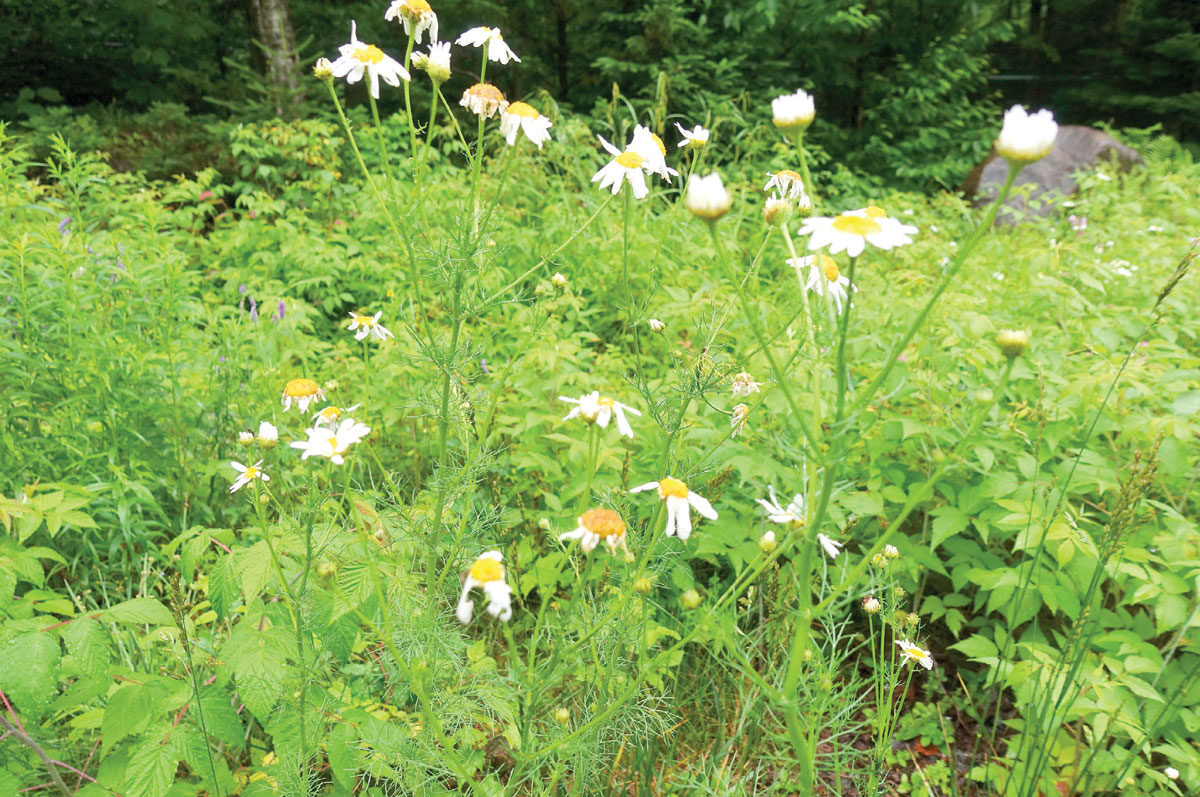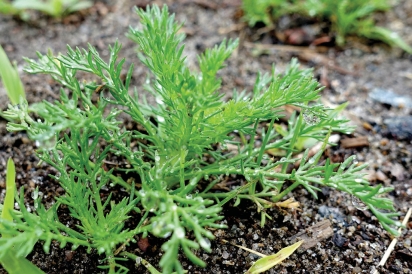Eating Wild: Sweet and Soothing- Wild Chamomile and Pineappleweed
To say that I drink tea all day is barely hyperbole. Those who know me often gently make fun of the fact that I go directly from drinking coffee to tea at around 10 each morning, and that the steeped brew in my mug – that I continue to resupply until evening arrives – is most often a medley of foraged plants that have been mixed and matched to suit my mood.
The list of roots, leaves, stems, bark, flowers, and seeds that can be harvested from the wild and transformed into a cozy, invigorating, or medicinal tea goes on and on. And much like I wrote about recently with regard to soup, there really is a perfect tea, or many perfect teas, for every season. On cold winter days I can be found with conifer needles, including those from white pine, balsam, and cedar, in my cup, the steamy mix giving off the familiar fragrance of the holidays or a walk through the woods. In early spring I look for the first flowers of the season (dandelion, violet, coltsfoot) or wintergreen leaves and yellow birch twigs, two unrelated plants that contain a nearly identical essential oil.
Throughout the summer, the bounty really is endless, and includes plants that many people have never heard of before, as well as some that even the most casual tea drinker would recognize on a café menu. Mint, which I’ve profiled here, is arguably the most recognizable plant that can be foraged for and enjoyed as herbal tea. But trailing just behind in terms of familiar names is that common evening favorite, served up by grandmothers, bookshop frequenters, and restless sleepers alike: chamomile.
Chamomile (Latin name: Matricaria chamomilla) has been consumed as tea for thousands of years, with documentation tracing the drink back to Ancient Egypt and Rome, and its popularity across the world is still going strong. It is the go-to tea choice for a cozy evening, and is probably the most famous tea used to help with sleep. Due to this long-lasting and widespread popularity, the variety of this flavorful plant that shows up in tea tins is not only a common cultivar, but a prolific naturalized plant that has escaped gardens and now grows wild all around the world.
Though the plant is an annual, chamomile’s ability to spread easily from seed means that it generally returns each year wherever it grows. Like so many plants that show up on the common foragables list, it thrives in both full and partial sun, and often grows around the edges of disturbed soil. I have encountered the plant most frequently around dirt paths and roadsides, making it easy to locate but often discovered in places I don’t feel comfortable harvesting from due to roadside runoff or foot traffic. Also like so many plants in the list of forage favorites, there’s a very good chance that you have passed by this fairly unassuming plant countless times without noticing.
Wild chamomile shares most of its habitat preferences, as well as its identifying characteristics, with a very close relative that can be used in many of the same ways: pineappleweed. Both wild chamomile and pineappleweed (Latin name: Matricaria discoidea) are members of the Asteraceae family, and bear the trademark composite flower – many tiny flowers that present as one larger one – that is far more noticeable on other, larger Asteraceae species like dandelion and sunflower. Since both wild chamomile and pineappleweed have such small flowerheads, measuring less than an inch across and often quite a bit smaller, you have to look very closely to notice that what presents as one flower is actually many. If you have a small magnifying glass and catch the plants when they are in bloom, I highly recommend taking a moment to appreciate these tiny marvels of nature.
Wild chamomile and pineappleweed both have finely-divided, almost feathery bright green leaves, though their foliage is much less perfectly feathery than that of the yarrow plant, and more succulent-like than that of the Apiaceae family members carrot or parsley. The biggest differences between wild chamomile and pineappleweed, other than the decidedly “pineappley” scent and flavor that gives the latter its name, is the height to which they grow, and the appearance of their flowerheads.
Often reaching two to three feet in height, wild chamomile often towers over the few inches to one-foot height of pineappleweed. It is also quite a bit leggier than its botanical cousin and has white ray flowers around the outside of the flowerheads that present as petals. These white ray flowers give chamomile flowerheads a daisy-like appearance that is the easiest distinguisher between it and pineappleweed, which bears small, ball-like, and petal-less yellow/green flower heads instead.
When flowers and foliage are crushed, wild chamomile has the sweet and floral scent we are so familiar with from the tea we find in stores. Pineappleweed contains many of those same notes, but also carries with it a strong and striking pineapple essence that I honestly prefer to chamomile, and that those new to foraging often find delightful when I crush some for them to smell.
If you have done your due diligence in plant identification and are sure you have found wild chamomile and/or pineappleweed, both can be harvested for use from mid-summer throughout the fall without much worry about damaging plant populations as long as you don’t pull out their roots. While many foragers only take the flowers from these plants, I find the leaves to be equally flavorful, and like to collect and use them as well. All the harvested parts can then be used on their own or together, fresh or dried in a number of ways that generally begin by making an herbal tea infusion.
To make an herbal tea infusion simply boil water as you would for any tea, let it cool for a few minutes, and pour over either fresh or dried flowers and leaves from one or both plants. Allow the infusion to steep for as long as you like, but I recommend a minimum of 5 minutes. The tea can then be enjoyed as it is, with sugar or honey, or transformed into a number of other recipes by turning the tea into a simple syrup. To make a syrup, measure out the liquid and then add an equal amount of sugar, heating it through until the sugar is just dissolved. The syrup can then be used as an ingredient in mixed drinks, boiled down into candy, included in a fruity homemade sherbet, or used to make a glaze for baked goods like cakes and cookies. I often leave the plant parts in my tea if I am drinking it immediately, but strain them out if I will be using the infusion to make a syrup. Flowers and delicate top leaves can also be chopped and tossed into summery soups or salads, or mixed into the dough of sugar cookies or shortbread cookies. I have also added them into salad dressings, and think they pair nicely with recipes involving goat cheese and honey.
Both plants dry well. They can be hung in bunches until they are completely dried out and brittle before being stored in airtight jars, or placed in a food dehydrator on the lowest setting until all the moisture has been removed. You want your leaves and flowers to retain their color and flavor, so be cautious about dehydrating at too high a temperature or for too long.
One of the nicest things about having a cabinet full of dried foraged herbs and edible blossoms is being able to offer them as tea for guests. It is a lovely feeling, when a friend requests a steamy mug of chamomile, to present them with wild-picked flowers instead of a traditional teabag, to tell them where you found the fragrant plants growing, and to sit down to share a drink that people across the world have been enjoying together for generations.
*NOTE: Always consult with trusted experts and refer to foraging books and field guides for 100% positive plant identification before consuming any wild plant. As with harvesting any wild plant, and particularly ones like wild chamomile and pineappleweed that grow in commonly-sprayed areas, take particular care to collect from spaces you know to be chemical-free. Never pick any wild plant from protected spaces. Integrate new foods into your diet in small quantities to gauge any dietary sensitivities, and consult with a doctor if you have any questions or concerns about specific health issues or medication interactions.
Becca Miller lives in the Adirondack Mountains and works as a professional farm-to-classroom educator, writer, and photographer. A former Cape Codder in residence but always a Cape Codder at heart, Becca spent her time living on the Cape running a CSA program where she taught members how to use harvest items in new and creative ways. Becca is a Certified Master Food Preserver and a Leave No Trace Trainer, and her writing has been featured in Edible Capital District, Edible Vermont, and Adirondac magazines, along with Alice Waters’ Edible Schoolyard blog and Mother Earth Living’s Food Matters blog. Find Becca’s writing at beccamillerwriting.weebly.com





